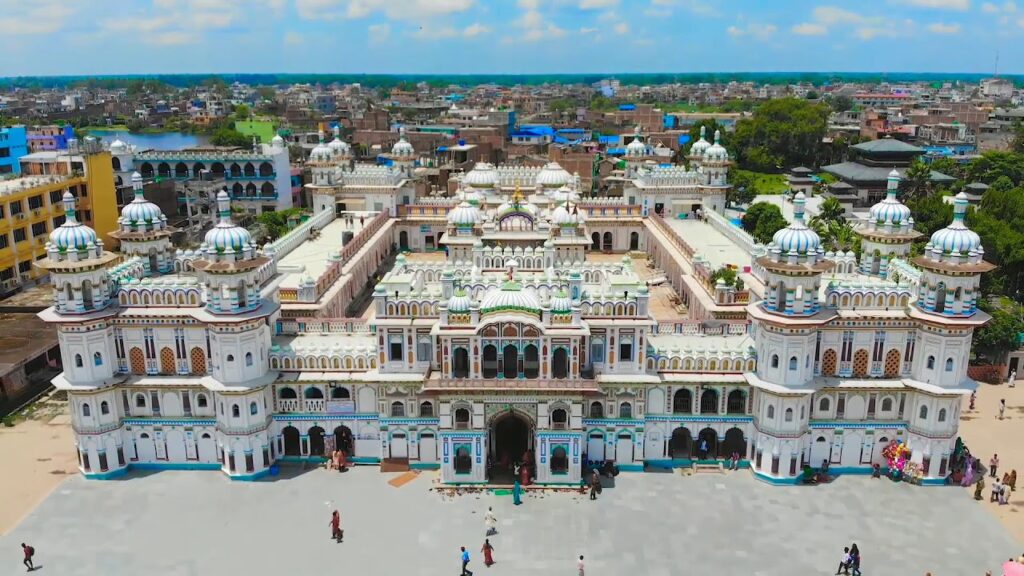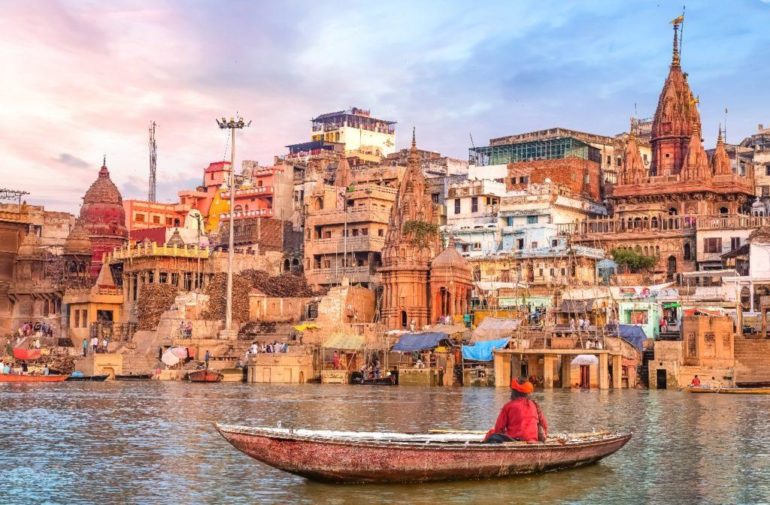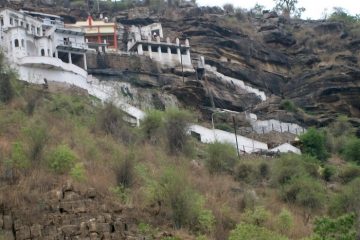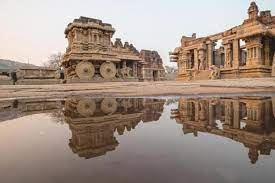Shri Ramayana Yatra
- Tour code : 201716
- Visiting : Delhi – Ayodhya – Sitamarhi – Janakpur – Varanasi – Prayag – Chitrakoot – Nasik – Hampi – Rameshwaram – Delhi.
- 17 Days / 16 Nights
- Cost per person (Click here to know)
- Flights
- Accommodation
- Local Transport
- Meals
Day 1: Arrive at Delhi Safdarjung
- Departure of train at18:00 hrs
- Dinner onboard. Overnight train Journey.
- Night Stay @ hotel
Day 2: Reach Ayodhya
- Morning Tea & Breakfast onboard.
- Arrival at Ayodhya Railway station.
- Transfer to the accommodation places.
- Full day visit of various temples at Ayodhya.
- Evening Saryu Arati. Bhjan and Kirtan programme.
- Night Stay @ hotel
Day 3: Ayodhya-Nandigram
- After breakfast proceed to visit Nandigram (20 Km from Ayodhya).
- Return to Ayodhya Railway station in Afternoon.
- Departure of train to Sitamarhi.
- Evening Tea Onboard.
- Dinner onboard.
- Overnight train Journey
Day 4: Sitamarhi-Janakpur
- Morning Tea & Breakfast onboard.
- Arrival at Sitamarhi Railway station at morning.
- Transfer to Janakpur in Nepal (35 Km from Sitamarhi) by buses.
- Transfer to the accommodation places.
- Visit Ram-Janaki Mandir at Janakpur. Evening free.
- Dinner & Overnight stay at Janakpur.
Day 5: Janakpur-Sitamarhi
- After breakfast proceed to Sitamarhi.
- Visit Janaki Mandir at Sitamarhi and Punaura.
- Lunch onboard.
- Departure of train to Varanasi at afternoon.
- Evening Tea Onboard.
- Dinner Onboard & Overnight train Journey.
Day 6: Varanasi
- Morning Tea & Breakfast onboard.
- Arrival at Varanasi Railway station at morning.
- Transfer to the accommodation places.
- Full day visit of Tulsi Mandir, Sankat Mochan Hanuman Mandir and Vishwanath Mandir.
- Evening Ganga Arti.
- Dinner & Overnight stay a Varanasi.
Day 7: Prayag
- After breakfast proceed to Sita Samahit sthal enroute to Prayag (80 Km).
- Visit Sita Samahit sthal.
- Proceed to Prayag (40 Km).
- Evening Visit Bharadwaj Ashram at Prayag.
- Dinner & Overnight stay at Prayag.
Day 8: Prayag-Chitrakoot
- Early morning have sacred bath and darshan at Hanuman temple at Sangam Prayag.
- Proceed to visit Shringaverpur (40 Km/1 hour from Prayag)
- Visit temples at Shringaverpur.
- Lunch
- Proceed to Chitrakoot. (75 Km/ 3 hours.)
- Evening Visit of Ramghat at Chitrakoot.
- Dinner & Overnight stay a Chitrakoot.
Day 9: Chitrakoot-Nasik
- Early morning sacred bath in Mandakini river at Chitrakoot.
- Proceed to visit Temples, Sati Anusuiya Ashram, Gupta Godavari, Hanuman Dhara etc at Chitrakoot.
- Lunch
- Evening proceed to Manikpur Railway station.
- Departure of train to Nasik at 19:00
- Dinner onboard & Overnight train Journey
Day 10: Nasik
- Morning Tea & Breakfast Onboard.
- Lunch onboard.
- Evening arrival at Nasik Road Railway station.
- Transfer to the accommodation places.
- Dinner & Overnight stay a Nasik.
Day 11: Nasik
- Post breakfast proceed to visit Trayambakeshwar.
- Return to Nasik.
- Visit Panchavati area in Nasik.
- Return to Nasik Road Railway station.
- Departure of train to Hospate at 1900 hrs.
- Dinner onboard & Overnight train Journey.
Day 12: Hampi
- Morning Tea & Breakfast Onboard.
- Lunch onboard.
- Evening Tea Onboard.
- Evening arrival at Hospate Railway station.
- Transfer to the accommodation places at Hampi.
- Dinner & Overnight stay a Hampi.
Day 13: Hampi
- Post breakfast proceed visit Various temples at Hampi.
- Lunch
- Return to Hospate Railway station.
- Departure of train at 19:30 hrs for Rameshwaram.
- Dinner onboard & Overnight train Journey.
Day 14: Rameshwaram
- Morning Tea & Breakfast Onboard.
- Lunch onboard.
- Evening Tea Onboard.
- Evening arrival at Rameshwaram Railway station.
- Transfer to the accommodation places at Rameshwaram.
- Dinner & Overnight stay a Rameshwaram.
Day 15: Rameshwaram
- Visit Rameshwaram temple.
- Lunch
- Visit Dhanushkodi.
- Return to Railway station
- Departure of train at 18:00 hrs to Delhi.
- Dinner Onboard &Overnight Journey.
Day 16: Train Journey
- Morning Tea & Breakfast Onboard.
- Wash & Change onboard.
- Lunch Onboard.
- Evening Tea on board.
- Dinner on board & overnight train journey.
Day 17: Delhi-Safdarjung
- Morning Tea & Breakfast Onboard.
- Wash & Change onboard
- Afternoon arrival DSJ Railway station.
- TOUR ENDS WITH HAPPY MEMORIES.
- If interested, you may continue this epic trip to visit amazing temples in Sri Lanka on a 8D/7Nfrom Rameshwaram.reach us to know more or check to see Ramayana Yatra - itinerary of Srilanka( Click here
Itinerary is tentative and can be changed or modified subject to smooth and timely running of Train. The final Timing will be based on the Train order received from the railways.
1) Ayodhya
Ayodhya is a city situated on the banks of holy river Saryu in the Indian state of Uttar Pradesh. It is the administrative headquarters of Faizabad district and the Faizabad division of Uttar Pradesh, India.It shares a municipal corporation with its neighbouring twin city of Faizabad.Ayodhya, also known as Saket, is an ancient city of India, is the birthplace of Bhagwan Shri Ram and setting of the great epic Ramayana. Ayodhya used to be the capital of the ancient Kosala Kingdom. It has an average elevation of 93 meters (305 feet). Owing to the belief as the birthplace of Bhagwan Shri Ram, Ayodhya(Awadhpuri) has been regarded as first one of the seven most important pilgrimage sites(Mokshdayini Sapt Puris) for Hindus.
2) RAMKOT
Ramkot is the main place of worship in Ayodhya, and the site of the ancient citadel of its namesake, standing on elevated ground in the western city. Although visited by pilgrims throughout the year, it attracts devotees from all over the world on "Ram Navami", the day of the birth of Rama. Ram Navami is celebrated with great pomp in the Hindu month of Chaitra, which falls between March and April. Swarg Dwar is believed to be the site of cremation of Rama. Mani Parbat and Sugriv Parbat are ancient earth mounds, the first identified by a stupa built by the emperor Ashoka, and the second is an ancient monastery. Treta ke Thakur is a temple standing at the site of the Ashvamedha Yajnya of Rama. Three centuries prior, the Raja of Kulu built a new temple here, which was improved by Ahilyabai Holkar of Indore in 1784, the same time the adjacent Ghats were built. The initial idols in black sandstone were recovered from Sarayu and placed in the new temple, which was known as Kaleram-ka-Mandir. Chhoti Devkali Mandir is the temple of goddess Ishani, or Durga, Kuldevi of Sita.
3)Janaki Mandir
The Janaki Mandir temple is in the centre of Janakpur, northwest of the bazaar. It is one of the biggest temples in Nepal and was built in 1898 (1955 in the Nepali calendar) by Queen Brisabhanu Kunwari of Tikamgarh. It is also called Nau Lakha Mandir after the cost of construction, said to be nine lakh rupees. The temple is architecturally unique in Nepal: its inner sanctum contains a flower-covered statue of Sita that was found in the Sarayu near Ayodhya. Statues of Rama and his half-brothers Lakshman, Bharat, and Satrughna stand by Sita.
Adjacent to the Janaki Mandir is the Rama Sita Vivaha Mandir, a building that marks the event in which Rama and Sita were married. The oldest temple in Janakpur is Sri Ram Temple, built by the Gorkhali General Amar Singh Thapa. Pilgrims also visit the over 200 sacred ponds in the city for ritual baths. The two most important ponds – Dhanush Sagar and Ganga Sagar, are located close to the city center.
4)Varanasi
Varanasi also known as Kashi or Benares or Banaras, is a city on the banks of the river Ganges in Uttar Pradesh, India, 320 kilometres (200 mi) south-east of the state capital.
According to Hindu mythology, Varanasi was founded by Shiva,one of three principal deities along with Brahma and Vishnu. During a fight between Brahma and Shiva, one of Brahma's five heads was torn off by Shiva. As was the custom, the victor carried the slain adversary's head in his hand and let it hang down from his hand as an act of ignominy, and a sign of his own bravery. A bridle was also put into the mouth. Shiva thus dishonored Brahma's head, and kept it with him at all times. When he came to the city of Varanasi in this state, the hanging head of Brahma dropped from Shiva's hand and disappeared in the ground. Varanasi is therefore considered an extremely holy site.
5) Prayagraj
Prayagraj is crowned in ancient scriptures as ‘Teertharaj’ and is considered one of the holiest pilgrimage centres of India. The Kumbh held in four sacred places of India and Prayagraj is one of them. A city of many dimensions is what befits the description of Prayagraj. In addition to being a major pilgrimage centre, the city has played an important part in the formation of modern India. Hindu mythology states that Lord Brahma, the creator, chose a land for the 'Prakrishta Yajna'. This land, on the confluence of three holy rivers - Ganga, Yamuna and Saraswati, blessed by gods, came to be known as Prayagraj. Prayagraj became the headquarters of Northwestern Provinces, after being shifted from Agra. Many important events in India's struggle for freedom took place here.
6) Chitrakoot
Chitrakoot a village of religious importance which interestingly lies half in Madhya Pradesh and the other half in Uttar Pradesh. This is one among the important places connected to Ramayana where Bharat persuaded Lord Rama to return to Ayodhya and where Lord Rama performed his father Dasharatha's last rites in presence of all the Gods and Goddesses. 6.1) Ram Ghat Located at the centre of the town, this is where Lord Rama used to take a dip in river Mandakini during his stay at Chitrakoot. Get soaked in the serenity of this place with a holy dip in Ram Ghat. 6.2) Bharat Milap Mandir this is where Bharat met his brother Lord Rama to persuade him to return to Ayodhya. It is said that the meeting of four brother was so emotional that even the rocks and mountains of Chitrakut melted. There are evident footprints of Lord Ram and his brothers here that are worshipped. This is located on the Kamdagiri Hills, which when circumambulated (parikrama) is believed to liberate people from their sins.
6.3) Hanuman Dhara
It is a spring located on a hilltop, said to have been created by Lord Rama to soothe Hanuman when the latter returned after setting Lanka ablaze. The temple here has five faced Hanuman deity. One has to climb close to 600 odd steps to reach the Dhara. The spring water falls directly on to the idol providing a surreal look.
7.1)Nashik
The name of the city derives from the incident the place is most famous for – the cutting off of Surpanaka’s nose by Lakshmana. If you are not familiar with Hindu mythology, that bit comes from one of our most popular epics – the Ramayana. It is believed that Rama, Lakshmana and Sita stayed here during their 14 year exile from Ayodha. This is where they attracted the attention of the demons, in the form of Surpanakha, the sister of Ravana, who was attracted to Rama. To teach her a lesson, Lakshmana disfigured her by cutting off her nose, thus giving this place the name – Nasika – meaning nose. Over the centuries, the place came to be known as Nasik or Nashik. This is also believed to be the place where Ravana, hearing of the beauty of Sita, abducted her, which led to the events so well told in the Ramayana.
7.2) Nashik is also where the river Godavari comes down from the mountains, and on her banks are temples galore. We start our tour at the Ramkund, where Rama is believed to have bathed in the Godavari. Around the Ramkund are located most of the temples in Nashik, but this post is not about them. This post is about the temples related to stories from the Ramayana.
7.3) Our first halt is at one of the most popular places in Nashik – Panchavati. The place gets its name from the five banyan trees which stand here, in a sort of a circle. They are conveniently numbered for the pilgrims who throng here at all times of the year.
The whole area must have been a thick forest at the time the events of the Ramayana took place, so it is difficult to imagine the exact place that Rama’s ashram existed. However, the ring of five trees is described in many versions of the epic, so this is believed to be the general area of the ashram. Located here today is one of the most famous temples in Nashik –
The Kala Ram Temple.
The name of the temple derives from the black stone statue of Lord Ram in the sanctum. Considering that most idols in northern India are made of marble, this itself is an oddity and an interesting thing about this temple. While the site of the temple is an ancient one, the present structure was built by the Peshwas, about 200 years ago.
7.4) Very near this temple is the Sita Gumpha, or Sita’s cave. It is believed that Sita was hidden here for a while when Rama and Lakshmana went in search of the golden deer.
7.5) A little further on, we come to a bridge. It is apparently called the Lakshman Bridge, and is believed to be the site of the legendary ‘Lakshman Rekha’ or the line that Lakshmana had drawn to protect Sita.
To justify the belief, there is also a small shrine just next to the bridge. Here is a small idol of Sita, and just outside, a small figure of Ravana!
8)Hampi
The place is treated sacred since it is one of the important Places connected to Ramayana.
Hampi is one of the major religious destinations in India,This is where Lord Rama and Lakshmana met Lord Hanuman while in search of abducted Sita. Many of the places mentioned in the Kishkinda Kanda are found here in Hampi. Hampi is also world famous for it's exceptional and stunning style of architecture found in the temples and monuments which dates back to the Vijayanagara reign. It is one of the major tourist destinations in Karnataka which attracts travellers from world wide. 8.1) Anjanadri hills : Anjanadri hills in Hampi is believed to be the birthplace of Hanuman. At the top of the hill is a temple dedicated to Hanuman. 8.2) Rishimukh island : Rishimukh island is the place where Hanuman first met Lord Rama and Lakshmana who were in search of Sita abducted by Ravana. The hills and environs fall in the habitual laid back character of Hampi. 8.3) Sugreeva's cave : Sugreeva's cave can be spotted on the way to the King's balance from the Kodandarama Temple. The marks on the rock surface here are equated with the motifs on Sita's sari (costume). Next to it is a pond known after Sita's name. 8.4) Chintamani temple : Chintamani Temple in Hampi is a rich repository of legends. It is home to the cave in which Rama met Sugreeva along with Lord Hanuman for the first time to seek assistance in finding Sita. The Chintamani Temple was consequently developed by a saint who created a Sivalingam and Annapurani below a marvellous Rudraksha Mandapam. Sree Chakram or the Disc of God is also installed here. 8.5) Malyavanta Raghunatha Temple : From a religious and mythological point, the Malyavanta Raghunatha temple dedicated to Lord Rama is very significant. It is one of the important places visited by Lord Rama where Lord Rama and Lakshmana took shelter to see off monsoons before proceeding to Lanka.
9)Rameswaram
is where Lord Rama built Rama Sethu across the sea to Lanka to rescue Sita from Ravana. After slaying Ravana, Subsequently, Lord Rama returned here and offered his repentance prayer to Lord Siva to absolve his sins that he had committed by slaying Ravana. This legend is the main reason for Rameswaram to become one of the major religious destinations in India. The name of the place is derived from a Sanskrit word which literally means "The place where Eswara was worshipped by Rama". Let's see what makes Rameswaram one among the important places connected to Ramayana.
9.1) Ramanathaswamy Temple
is the most attractive site in the holy city of Rameswaram. This is one of the very few temples in India which is built in the Dravidian style of architecture and also has the world's second largest pillared corridor in the world! Of the 24 important sacred Theerthas ,14 are present within the temple precincts. The temple is also one of the 12 Jyotirlinga shrines.
Holy Theerthams!
There are 64 holy Theerthams in Rameswaram of which 24 are important. The foremost one among them is called Agni Theertham. These Theerthams are believed to wash away the sins of people who take a dip in them.
9.2) Dhanushkodi
Dhanushkodi is an abandoned town in the southern most tip of Pamban island. Lord Rama built the Rama Setu here. The pilgrims usually bath in the ocean here before completing the pilgrimage to Rameswaram. The spot is considered a sacred confluence of the Bay of Bengal and the Indian Ocean.
9.3) Kothandaramaswamy Temple
is a ruin of the temple described in Ramayana. It is believed to be the residing spot of Vibhishana, the younger brother of Ravana.
9.4) The five faced Hanuman Temple
This is another important temple in Rameswaram which has the famous five manifestations of Lord Hanuman. This famous idol is carved out of a large Senthooram Stone which was considered very precious in ancient times.
There is more to Rameswaram than these holy spots! The serene and tranquil beaches here are sure to soothe your soul. India's first sea bridge, the Pamban bridge is an attraction on it's own. These features make Rameswaram one of the Major tourist attractions in Tamil Nadu. Go and get dipped in the serenity of Rameswaram
Inclusions:
- Train Journey by Special tourist train in 1st AC/2ndAC class.
- 08 Nights stay in deluxe category available accommodation as per itinerary.
- 08 Nights stay in respective Rail coaches during overnight train journey.
- Onboard train meals (veg only): will be served in Rail restaurants.
- Off board meals (veg only) in good quality Hotels.
- All Transfers and sightseeing in AC vehicles.
- Travel insurance for the passengers.
- Tour Managers will travel throughout the tour for necessary assistance.
- Security on Train.
- All applicable Taxes.
Exclusions:
- Boating, adventure sports etc.
- Meals are preset and a choice of menu is not available.
- Any room service will be chargeable.
- Cost of sightseeing, entrance and local guides etc. not included in the itinerary.All kind of tips to drivers, waiters, guides, representative, Fuel Surcharge, etc.
- Any expenses of personal nature such as laundry expenses, mineral water, food and drinks not in the regular menus provided by us.
- Anything not included in the inclusions.
Bookings: Cancellations:




Get in touch with our travel expert
- 040-40164248 | +91 80080 03718
- info@saradhitcpl.com
- 040-40164248 | +91 80080 03718
- saradhitppl@gmail.com


